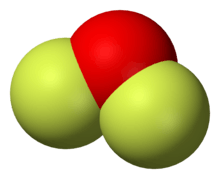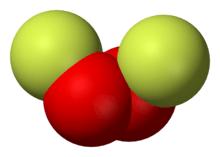Oxygen fluoride
Oxygen fluorides are compounds of elements oxygen and fluorine with the general formula OnF2, where n = 1 to 6. Many different oxygen fluorides are known:
- oxygen difluoride (OF2)
- dioxygen difluoride (O2F2)
- trioxygen difluoride or ozone difluoride (O3F2)[1][2]
- tetraoxygen difluoride (O4F2)[3]
- pentaoxygen difluoride (O5F2)
- hexaoxygen difluoride (O6F2)[4]
- dioxygen monofluoride(O2F)


Oxygen fluorides are strong oxidizing agents with high energy and can release their energy either instantaneously or at a controlled rate. Thus, these compounds attracted much attention as potential fuels in jet propulsion systems.[5]
Synthesis
Here are some synthesis methods and reactions of the three most common oxygen fluorides – oxygen difluoride (OF2), dioxygen difluoride (O2F2) and ozone difluoride (O3F2).
Oxygen difluoride (OF2)

A common preparative method involves fluorination of sodium hydroxide:
OF2 is a colorless gas at room temperature and a yellow liquid below 128 K. Oxygen difluoride has an irritating odor and is poisonous.[3] It reacts quantitatively with aqueous haloacids to give free halogens:
It can also displace halogens from their salts.[3] It is both an effective fluorinating agent and a strong oxidizing agent. When reacted with unsaturated nitrogen fluorides with electrical discharge, it results in the formation of nitrogen trifluoride, oxide fluorides and other oxides.[6][7]
Dioxygen difluoride (O2F2)

O2F2 precipitates as a brown solid upon the UV irradiation of a mixture of liquid O2 and F2 at -196 °C.[8] It also only appears to be stable below -160 °C.[9] The general method of preparation of many oxygen fluorides is a gas-phase electric discharge in cold containers including O2F2.[10]
It is typically an orange-yellow solid which rapidly decomposes to O2 and F2 close to its normal boiling point of about 216 K.[3]
O2F2 reacts violently with red phosphorus, even at -196 °C. Explosions can also occur if Freon-13 is used to moderate the reaction.[9]
Trioxygen difluoride (O3F2)
O3F2 is a viscous, blood-red liquid. It remains liquid at 90 K and so can be differentiated from O2F2 which has a melting point of about 109 K.[11][3]
Like the other oxygen fluorides, O3F2 is endothermic and decomposes at about 115 K with the evolution of heat, which is given by the following reaction:
O3F2 is safer to work with than ozone, and can be evaporated, or thermally decomposed, or exposed to electric sparks, without any explosions. But on contact with organic matter or oxidizable compounds, it can detonate or explode. Thus, the addition of even one drop of ozone difluoride to solid anhydrous ammonia will result in a mild explosion, when they are both at 90 K each.[3]
Dioxygen monofluoride
Dioxygen monofluoride is a molecule such as O-O-F, whose chemical formula is O2F and is stable only at low temperature. It has been reported to be produced from atomic fluorine and dioxygen[12].
General preparation of polyoxygen difluorides
| Reaction equation[6] | F2:O2 by volume | Current | Temperature of bath (°C) |
|---|---|---|---|
| 1:1 | 10–50 mA | ~ -196° | |
| 2:3 | 25–30 mA | ~ -196° | |
| 1:2 | 4 – 5 mA | ~ -205° |
Effects on ozone
Oxygen- and fluorine-containing radicals like FO2 and FO occur in the atmosphere. These along with other halogen radicals have been implicated in the destruction of ozone in the atmosphere. However, the fluorine oxide radicals are assumed to not play as big a role in the ozone depletion because free fluorine atoms in the atmosphere are believed to react with methane to produce hydrofluoric acid which precipitates in rain. This decreases the availability of free fluorine atoms for oxygen atoms to react with and destroy ozone molecules.[13]
Hypergolic propellant
Despite the low solubility of O3F2 in liquid oxygen, it has been shown to be hypergolic with most rocket propellant fuels. The mechanism involves the boiling off oxygen from the solution containing O3F2, making it more reactive to have a spontaneous reaction with the rocket fuel. The degree of reactivity is also dependent on the type of fuel used.[3]
See also
References
- Solomon, I. J. et al. (1968). "Additional Studies Concerning the Existence of O3F2". Journal of the American Chemical Society. 90 (20): 5408–5411. doi:10.1021/ja01022a014.CS1 maint: uses authors parameter (link)
- Misochko, Eugenii Ya, Alexander V. Akimov, Charles A. Wight (1999). "Infrared spectroscopic observation of the stabilized Intermediate complex FO3 formed by reaction of mobile Fluorine atoms with ozone molecules Trapped in an Argon Matrix". The Journal of Physical Chemistry A. 103 (40): 7972–7977. Bibcode:1999JPCA..103.7972M. doi:10.1021/jp9921194.CS1 maint: uses authors parameter (link)
- Streng, A. G. (1963). "The Oxygen Fluorides". Chemical Reviews. 63 (6): 607–624. doi:10.1021/cr60226a003.
- Streng, A. G., A. V. Grosse (1966). "Two New Fluorides of Oxygen, O5F2 and O6F2". Journal of the American Chemical Society. 88: 169–170. doi:10.1021/ja00953a035.CS1 maint: uses authors parameter (link)
- Jäger, Susanne et al. (1986). "Fluorine and Oxygen". Fluorine. Berlin, Heidelberg: Springer. pp. 1–161.CS1 maint: uses authors parameter (link)
- Nikitin, Igor Vasil'evich, and V. Ya Rosolovskii (1971). "Oxygen Fluorides and Dioxygenyl Compounds". Russian Chemical Reviews. 40 (11): 889–900. Bibcode:1971RuCRv..40..889N. doi:10.1070/rc1971v040n11abeh001981.CS1 maint: uses authors parameter (link)
- Lawless, Edward W., Ivan C. Smith (1968). Inorganic high-energy oxidizers: synthesis, structure, and properties. M. Dekker.CS1 maint: uses authors parameter (link)
- Marx, Rupert, Konrad Seppelt (2015). "Structure investigations on oxygen fluorides". Dalton Transactions. 44 (45): 19659–19662. doi:10.1039/c5dt02247a. PMID 26351980.CS1 maint: uses authors parameter (link)
- Solomon, Irvine J. Research on Chemistry of and . No. IITRI-C227-6. IIT RESEARCH INST CHICAGO IL, 1964.
- Goetschel, Charles T. et al. (1969). "Low-Temperature Radiation Chemistry. I. Preparation of Oxygen Fluorides and Dioxygenyl Tetrafluoroborate". Journal of the American Chemical Society. 91 (17): 4702–4707. doi:10.1021/ja01045a020.CS1 maint: uses authors parameter (link)
- De Marco, Ronald A., and Jean'ne M. Shreeve . "Fluorinated Peroxides." Advances in Inorganic Chemistry and Radiochemistry. Vol. 16. Academic Press, 1974. 109-176.
- J.L.Lyman and R. Holland, J. Phys. Chem.,1988,92, 7232.
- Francisco J. S. (1993). "An ab initio investigation of the significance of the HOOF intermediate in coupling reactions involving FOO x and HO x species". The Journal of Chemical Physics. 98 (3): 2198–2207. Bibcode:1993JChPh..98.2198F. doi:10.1063/1.464199.
External links
- National Pollutant Inventory - Fluoride and compounds fact sheet
- Oxygen Fluoride PubChem
- Center for Disease Control and Prevention - Health Hazards of Oxygen Difluoride